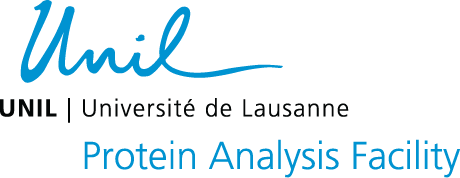General and practical infos
How to proceed to set up an experiment ?
Contact us by email or phone to discuss your project or experiment. For more in depth discussions we can organize a meeting in person or in remote via zoom. Unless you have previous experience of proteomics experiments, it is crucial that we discuss BEFORE you proceed with sample preparation. This will help minimize failure and frustration for everyone. Often we will suggest a pilot experiment that will be useful to assess feasibility.
PI’s preparing a grant application should contact us well in advance of the deadline to discuss the project and establish the necessary budget. We are happy to provide a letter of support and advice for experimental design and methods.
What techniques do you offer ?
Mass spectrometry is our main technology for untargeted protein and proteome analyses. We also offer targeted protein detection by capillary western assays (JESS).
Where can I find more infos or tutorials ?
Visit our info & downloads page.
I have samples ready, how do I submit them ?
Mass spectrometry workflows
Which type of samples can be analysed ?
We are equipped to handle a wide variety of samples, including cultured cells, biological tissues, and protein solutions. In many cases we do the extractions ourselves, unless you have specific experience. We have worked with many types of organisms and sorts of samples. However, we cannot guarantee that we will have a good recipe for everything !
How much protein material is needed ?
This depends critically on the biological question and the type of sample to analyse. For “normal” total proteome profiling (e.g. human cell lines), 200’000 cells are typically sufficient, equivalent to approximately 20 ug of total protein. Cell numbers needed may vary a lot depending on the size of cells. Extraction of tissues requires at least 1-2 milligrams of wet tissue (mammalian tissues) or 5-10 mg for plant tissues. For other types of material one should plan to have at least 20 ug actual protein material. Of course, having some spare sample is always recommended. Note that phosphoproteomics studies require more input, i.e. at least 150 ug protein per sample. On the other hand, in interactomics (affinity purifications) the final samples often contain low- microgram amounts. This is normal and is usually not a problem because such samples have lower complexity.
How many proteins can be profiled ?
This depends on the complexity and dynamic range of the sample (= distribution of abundances ). Up to 8000 proteins can be identified and quantitated in standard cultured cell lines in ideal conditions. In other samples, dominance by a few molecular species (ex. actin/myosin in muscle tissue, RUBISCO in plants or albumin in biofluids) can strongly limit the proteome coverage obtainable within reasonable measurement times. Nevertheless, meaningful data can be produced in these samples, too. Numbers of proteins identified in interactomics experiments can vary a lot, between a few hundreds to 3000-4000 depending on sample complexity and stringency of purification.
Do you analyze PTMs ?
We support large scale analyses of phosphoproteome and ubiquitinome. Other PTMs can often be analysed on defined target proteins, if appropriate mass spectrometry methods exist. NOTE : asking the question “ I want to know all about any modifications on my protein” is typically not a good strategy and rarely yields usable results (for many reasons). We recommend to have some hypotheses on the most likely PTM’s and we will try to verify them one by one.
What is the maximum number of samples in a project ?
For routine work, we typically handle projects involving up to 30 samples. Larger projects, accommodating up to 100 samples, are also possible but require detailed planning and prior discussion.
How long will it take to complete the analyses ?
“Small” experiments with less than 8 samples and direct processing can be carried out in 10-14 days (depending on the question). However this strongly depends on the workload that we are experiencing. This tends to vary strongly during the year and in an unpredictable manner.
What type of results will we receive ?
At the minimum you will receive a table with a list of proteins (or modification sites in case of PTM’s) and columns with associated quantitative values. Some statistical tests to compare conditions will be performed and a basic pathway enrichment analysis will be included in the case of quantitative experiments with replicates (data processing).
Is the facility taking care of downstream bioinformatic analysis ?
We can do some more advanced data processing and analysis. But we are not specialists in bioinformatics and we will only take you to a certain point. For multivariate statistics, clustering or in general more sophisticated data analyses we will redirect you to other core facilities at UNIL. Ultimately, the interpretation of your data is your task.
Simple Western
What is the technology for ?
JESS is made to detect and quantify proteins and or protein/isoforms in biological samples whenever a specific antibody is available. The technique is similar to a western blot, but is performed in capillaries.
What are its advantages relative to classical western blot ?
A JESS run requires lower amounts of proteins and antibodies than a classical western blot and can be performed in less than 4 hours. Furthermore, JESS is fully automated and thus less prone to technical bias as compared to western blot. JESS performs well with low and high molecular weight proteins since there is no transfer (proteins are bound to the capillary walls after migration). Capillaries being independent, 24 or 12 combinations of samples and antibodies can easily be done in parallel. Total protein normalization or a second immunodetection (for precious samples) can also be performed in the same run.
What are the sample requirements for Jess ?
Most of the classical protein extractions are compatible with a JESS run (RIPA, Laemmli buffer). Depending on the protein targets, different sample concentrations are required. Classicaly, 1 ug of protein and 0.2 ul of primary antibody are required per capillary.
How are Jess runs organized ?
A JESS run can be done with 12 or 24 independent samples. Just bring your samples and/or the primary antibodies. We do provide antibodies against some common targets.
For quantitative detection, a preliminary test run has to be performed to detect the linearity range of the sample and antibody response, as well as to validate the combination of different antibodies whenever required.
Which proteins could be detected by Jess ?
Each time there is an antibody directed against one particular protein/protein isoform, they can in principle be detected by JESS. Depending on the protein molecular weight, one of the 3 separation matrices can be used: 2-44 kDa, 12-230 kDa or 66-480 kDa.



